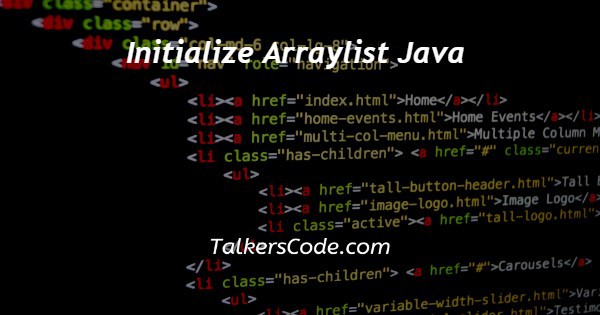In this article we will show you the solution of initialize arraylist java, an arrayList can be found in the java.util package as part of the collection framework.
We can create dynamic arrays in Java. In programs that require a lot of array manipulation, it can be useful, even though it is slower than standard arrays.
List is implemented by AbstractList, and ArrayList is derived from it.
ArrayList is initialised with a size, but the size can change as the collection grows or shrinks as objects are removed.
The Java ArrayList allows us to access the list at random. Integers, chars, and other primitive types cannot be used with an arrayList.
Data structures such as ArrayList are represented by the ArrayList class in Java, part of the "java.util" package.
As elements are inserted, they are stored in the order in which they were inserted in the Java ArrayList class.
The ArrayList supports the storage of duplicate elements. The main difference between the ArrayList and the Vector classes in Java is that the ArrayList is not synchronised.
In Java, the ArrayList uses indices like arrays and supports random access.
The operations that manipulate the elements in the ArrayList are slow because a lot of element shifting is required if any element is to be removed from the ArrayList.
The ArrayList class can only contain objects, not primitive types. An arraylist of objects is commonly used in this case.
So, if you want to store integer-type elements, you must use the wrapper class's Integer object rather than the primitive type int.
In addition to for-each loops, you can traverse an array list using the enhanced for loop.
Prior to Java 8, lambda expressions were not supported. However, starting with Java 8, you can include Lambda expressions in the for-each loop.
Step By Step Guide On Initialize Arraylist Java :-
import java.util.*;
public class TalkersCode{
public static void main(String args[]) {
List<String> myList = new List<String>(
Arrays.asList("Eleven", "Twelve", "Thirteen"));
System.out.println("List contents:"+myList);
}
}
- First, we must import the java.util function.
- Then we must create a class for executing the programme.
- We then create and initialise the arraylist object mylist using arrays as the list method.
- Finally, we print the arraylist.
- Finally, we close the programme with the system.out.printIn.
Conclusion :-
The ArrayList class can only contain objects, not primitive types. An arraylist of objects is commonly used in this case.
So, if you want to store integer-type elements, you must use the wrapper class's Integer object rather than the primitive type int.
In addition to for-each loops, you can traverse an array list using the enhanced for loop.
Prior to Java 8, lambda expressions were not supported. However, starting with Java 8, you can include Lambda expressions in the for-each loop.
I hope this article on initialize arraylist java helps you and the steps and method mentioned above are easy to follow and implement.














